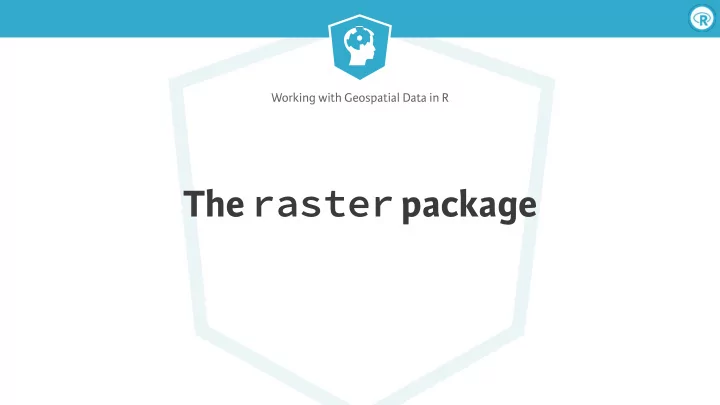

Working with Geospatial Data in R The raster package
Working with Geospatial Data in R Data frames aren’t a great way to store spatial data > head(preds) lon lat predicted_price 1 -123.3168 44.52539 258936.2 2 -123.3168 44.52740 257258.4 3 -123.3168 44.52940 255543.1 4 -123.3168 44.53141 253791.0 5 -123.3168 44.53342 252002.4 6 -123.3168 44.53542 250178.7 ● No CRS information ● Ine ffi cient storage ● Ine ffi cient display
Working with Geospatial Data in R A be � er structure for raster data ● data matrix + information on grid + CRS 258936.2 256579.2 254147.2 251593.8 … 258936.2 256579.2 254147.2 251593.8 … 257258.4 255082.5 252848.8 250499.2 258936.2 256579.2 254147.2 251593.8 … 257258.4 255082.5 252848.8 250499.2 255543.1 253557.9 251537.5 249410.6 257258.4 255082.5 252848.8 250499.2 255543.1 253557.9 251537.5 249410.6 253791.0 252004.4 250211.4 248326.8 255543.1 253557.9 251537.5 249410.6 253791.0 252004.4 250211.4 248326.8 … 253791.0 252004.4 250211.4 248326.8 … …
Working with Geospatial Data in R The raster package ● sp provides some raster data classes: ● SpatialGrid, SpatialPixels, SpatialGridDataFrame, SpatialPixelsDataFrame ● But raster is be � er: ● easier import of rasters ● large rasters aren’t read into memory ● provides functions for raster type operations ● Also uses S4 and when appropriate provides same functions
Working with Geospatial Data in R raster provides print methods for sp objects > library(sp) > countries_spdf An object of class "SpatialPolygonsDataFrame" Slot "data": name iso_a3 population gdp region 1 Afghanistan AFG 28400000 22270.00 2 Angola AGO 12799293 110300.00 3 Albania ALB 3639453 21810.00 … VERY long output! Slot "proj4string": CRS arguments: +proj=longlat +datum=WGS84 +no_defs +ellps=WGS84 +towgs84=0,0,0
Working with Geospatial Data in R raster provides print methods for sp objects > library(raster) > countries_spdf class : SpatialPolygonsDataFrame features : 177 extent : -180, 180, -90, 83.64513 (xmin, xmax, ymin, ymax) coord. ref. : +proj=longlat +datum=WGS84 +no_defs +ellps=WGS84 … variables : 6 names : name, iso_a3, population, gdp, min values : Afghanistan, -99, 140, 16.00, max values : Zimbabwe, ZWE, 1338612970, 15094000.00, … Compact and useful output
Working with Geospatial Data in R Let’s practice!
Working with Geospatial Data in R Color
Working with Geospatial Data in R A perceptual color space: HCL ● Trichromatic - we perceive color as three-dimensional h hue unordered (circular) c < < ? ? ? chroma ordered l luminance ordered Image credit: Hadley Wickham
Working with Geospatial Data in R Types of scale ● Sequential - ordered steps in chroma and/or luminance hue maybe redundant coding ● Diverging - ordered but in two directions steps in chroma and/or luminance with hue distinguishing direction ● Qualitative - unordered steps in hue with equal chroma and luminance
Working with Geospatial Data in R Generating color scales in R > library(RColorBrewer) > display.brewer.all() > brewer.pal(n = 9, "Blues") [1] "#F7FBFF" "#DEEBF7" "#C6DBEF" "#9ECAE1" [5] "#6BAED6" "#4292C6" "#2171B5" "#08519C" [9] "#08306B" > library(viridisLite) > viridis(n = 9) transparency [1] "#440154FF" "#472D7BFF" "#3B528BFF" "#2C728EFF" [5] "#21908CFF" "#27AD81FF" "#5DC863FF" "#AADC32FF" [9] "#FDE725FF"
Working with Geospatial Data in R Let’s practice!
Working with Geospatial Data in R Color scales 2
Working with Geospatial Data in R Mapping of numbers to color ● ggplot2 : map to a continuous gradient of color 250000 ● tmap : map to a discrete set of colors ● Continuous map: control mapping by transforming the scale, e.g log ● Discrete map: control mapping by binning 0.5 the variable
Working with Geospatial Data in R Discrete vs. continuous mapping ● Continuous: ● Perceptually uniform: perceiving equivalent color di ff erence to numerical di ff erence ● Discrete: ● Complete control over scale ● Easier lookup
Working with Geospatial Data in R Cu � ing a variable into bins > library(classInt) > classIntervals(values, n = 5, style = "equal") style: equal [190135.1,208293.7) [208293.7,226452.4) [226452.4,244611.1) 537 528 351 [244611.1,262769.7) [262769.7,280928.4] 131 53 > classIntervals(values, n = 5, style = "quantile") style: quantile [190135.1,201403.2) [201403.2,211412.2) [211412.2,220703.1) 320 320 320 [220703.1,237403.2) [237403.2,280928.4] 320 320
Working with Geospatial Data in R Cu � ing a variable into bins > classIntervals(values, n = 5, style = "pretty") style: pretty [180000,2e+05) [2e+05,220000) [220000,240000) [240000,260000) 279 664 394 199 [260000,280000) [280000,3e+05] 62 2 > classIntervals(values, style = "fixed", fixedBreaks = c(100000, 230000, 255000, 300000)) style: fixed [1e+05,230000) [230000,255000) [255000,3e+05] 1120 390 90
Working with Geospatial Data in R Let’s practice!
Recommend
More recommend